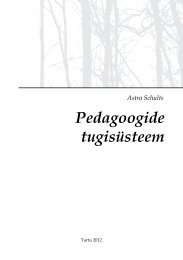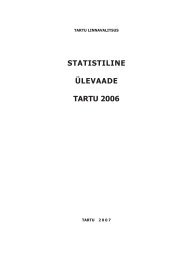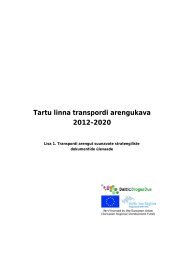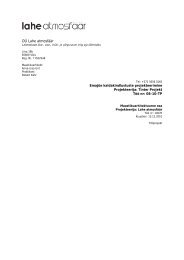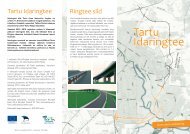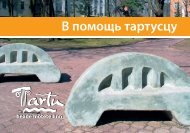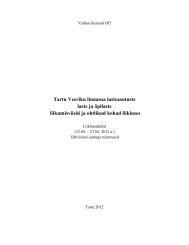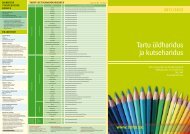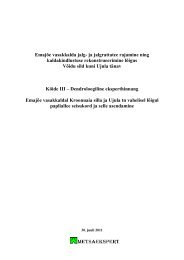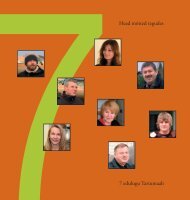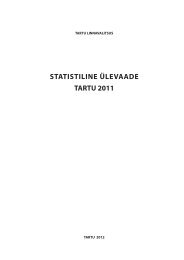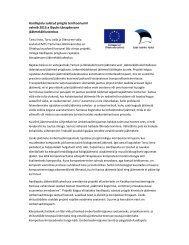Festivals - Tartu
Festivals - Tartu
Festivals - Tartu
You also want an ePaper? Increase the reach of your titles
YUMPU automatically turns print PDFs into web optimized ePapers that Google loves.
More radically, a site specific festival could be read as a plea for the comprehensive<br />
reinterpretation of the city, its entire urban tapestry, its reappraisal, its futuroplastic<br />
manifest. Take Malta, the site specific festival in Poznan, started originally around a<br />
recreational artificial lake Malta, at the city edge, showing that a sport resource could<br />
serve cultural purposes as well and appeal to a huge audience in an atmosphere of<br />
benevolence and relaxation, despite steady beer drinking. For more than a decade the<br />
festival has been moving towards the traditional city core, to rediscover and reposition<br />
various forgotten and ordinary city markers, use performances to make the citizens<br />
take pride in the traces of the Prussian architecture, and reclaim potential cultural<br />
hot spots from the encroaching mercantile capitalism with its aggressive billboards,<br />
neon slogans and standardized chain shops, always the same, in each city. Malta festival<br />
sooths the pain of urban transformation from socialism into capitalism, with real<br />
estate usually becoming a prime value and loosing its public character in intensifed<br />
privatisation transactions. At the same time, by keeping the regime of public urban<br />
space, Malta reclaims Poznan as a community of citizens rather than just letting it become<br />
a mass of 600.000 accidental consumers. The festival even turns this traditional<br />
commercial city, spared post-industrial debris, towards an appealing destination of<br />
cultural tourists, at least during this festive summer week.<br />
Of course, a festival could provide and profit from temporary structures, set apart<br />
from the architectural markers and prominent heritage spots. Like medieval and renaissance<br />
fairs, a festival erects its temporary festival city, its nomadic encampment,<br />
its bivouac of tents and summer pavilions, as in Nuernberg in the nineteen-eighties<br />
and for many years now at the lake shore during the Zommespektakel in Zurich. In<br />
this pavilion/tent city Zurich regains some of its historic linkage with the European<br />
avant-garde (Dada) and escapes its standard image, shaped by banks, jewelery stores<br />
and affluent bourgeois respectability, allows its citizens and visitors some relaxed hedonism,<br />
a bit of open-air extravaganza – and some extra decibels as well, combining<br />
the pleasures of the beach, food and art.<br />
The argument made here is to see a festival not only in terms of its artistic content but<br />
also spatial engagement, penetration of neuralgic urban spots and their appropriation,<br />
setting in the best cases a chain reaction of socio-economic, architectural and cultural<br />
transformation, upgrading and development; and in more modest cases creating temporary,<br />
exceptional zones of sociability and imagination, opposing the pattern of the<br />
seemingly rationalistic, market driven commercial exploitation of the urban space.<br />
2. 5. · Positioning and developing a festival<br />
38<br />
When viewed as an organized ephemeral event – “an extraordinary event, in an extraordinary<br />
place, at an extraordinary time”, if we may borrow from Wagner – a festival<br />
would appear to be the ideal “cultural product” on which to experiment and use



